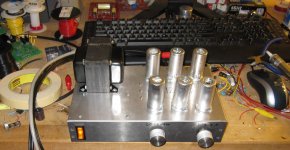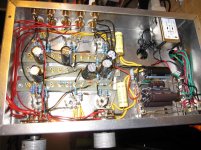What do you all think of this design (see attached PDF)? It features:
- A loudness (volume) control.
- 4 inputs for separate sources selectable by a rotary switch.
- 6x 12AU7 type vacuum tubes (three per stereo channel).
- All direct coupled interstage circuitry.
I finally found in my 12AU7 collection a combination of tubes that yields low thermal noise. Replacing the blue velvet pot with an ordinary Alpha 50k made the preamp sound so much better. 9:00 on the volume is significantly loud for most recordings into a modified MKIII.
What surprises me most of all is how lifelike this preamp sounds. I have been listening to some compressed recordings and CD's and the preamp really brings out the harmony (even in MP3s). What makes this design sound clear and not muddy like more conventional topologies? Is it DC coupling?
Hope to hear back.
- A loudness (volume) control.
- 4 inputs for separate sources selectable by a rotary switch.
- 6x 12AU7 type vacuum tubes (three per stereo channel).
- All direct coupled interstage circuitry.
I finally found in my 12AU7 collection a combination of tubes that yields low thermal noise. Replacing the blue velvet pot with an ordinary Alpha 50k made the preamp sound so much better. 9:00 on the volume is significantly loud for most recordings into a modified MKIII.
What surprises me most of all is how lifelike this preamp sounds. I have been listening to some compressed recordings and CD's and the preamp really brings out the harmony (even in MP3s). What makes this design sound clear and not muddy like more conventional topologies? Is it DC coupling?
Hope to hear back.
Attachments
I tested it and the feedback is all negative on both channels. When wiring, I by mistake miswired it and did oscillate like crazy. Fixed and all is good. Low noise, no oscillations of any kind, and very clean, detailed dynamics. I may have goofed the schematic. Will make a later revision if it contains an error.
Last edited:
I've done that and surprisingly it radiated interference well into the VHF TV band. 
Looks very well put together from the pictures, and I noticed the very clean electrical layout. Nice! I see so many projects both here and in real life that would be seriously embarrassed by that build quality.
Good end results often follow from the care taken in building, wish more people would figure that out.
Looks very well put together from the pictures, and I noticed the very clean electrical layout. Nice! I see so many projects both here and in real life that would be seriously embarrassed by that build quality.
Good end results often follow from the care taken in building, wish more people would figure that out.
Actually audio interestingly enough, there turned out to subsidiary stability problems which became obvious later. This was very early in my sojourn into tubes, 12AX7s on a wood breadboard with long fly leads between the sockets and the interconnection grid had a lot to do with it. (Big screws with lots of nuts and washers for holding wires and parts) Grid stoppers at the sockets killed most of the problems with this thing. I still have it, never use it.. lol
Looks very well put together from the pictures, and I noticed the very clean electrical layout. Nice! I see so many projects both here and in real life that would be seriously embarrassed by that build quality.
Good end results often follow from the care taken in building, wish more people would figure that out.
Thanks a bunch. I have been through the movie many times of sloppy building. At best, the SN ratio will be horrible. At worst, the thing will oscillate like a rabid dog.
Putting an active device in the feedback network is rather brave! You are relying on very good matching between triodes. Otherwise the feedback network could increase distortion. Scope for rather too many phase shifts in the loop, so HF instability could happen.
This is a good example of a circuit which will simulate much better than it works in real life.
This is a good example of a circuit which will simulate much better than it works in real life.
I did not match the tubes (it is true this design would perform better with it). The FFT registers some minor harmonic activity but did not get much of a THD fix.
Aside from that, I cannot hear any distortion whatsoever. The dynamics are detailed and rich. If distortion was a problem, how come it sounds good?
Aside from that, I cannot hear any distortion whatsoever. The dynamics are detailed and rich. If distortion was a problem, how come it sounds good?
Hey I get told my designs suck all the time, usually the comments relate to some design choice that I made that the individual disagrees with - obviously the fact that it both sounds good and I have the objective evidence that the performance is as expected is moot. 
(Note I do understand what his concern was..)
(Note I do understand what his concern was..)
Small amounts of low order distortion, which is what you are most likely to get, can sometimes sound 'better' than no distortion.kingneb said:Aside from that, I cannot hear any distortion whatsoever. The dynamics are detailed and rich. If distortion was a problem, how come it sounds good?
In this design you are relying on the curvature of the pairs of triodes exactly matching so that distortion in the forward path is cancelled by distortion in the feedback path. Any mismatch means distortion. Fortunately it will be mainly low order so it won't sound too bad. 'Rich' sound can be a symptom of this.
The music was lifelike to the point that certain songs (and passages) made me shiver and others made me tear up. There where some passages that even startled me despite hearing the music several times. This was compressed audio and CDs that did this. Imagine what it would be like once I get the phono preamp going.
What do you all think of this design (see attached PDF)?
Looks pretty good, though if there were a negative rail, then the first stage could be a true differential, instead of being two GK amps. That would improve the balance in that part of the circuit, instead of having to depend on 12AU7 section-to-section balance.
The other surprising things are that, since this includes an Aikido-type final, then I'd expect a capacitive divider between the positive rail and the grid of VT6 for hum bucking, as you find in the Aikido.
The other possibility, since this is a balanced topology in the first gain stages, is the "Broskie" balanced-to-unbalanced converter as a final.
What surprises me most of all is how lifelike this preamp sounds. I have been listening to some compressed recordings and CD's and the preamp really brings out the harmony (even in MP3s). What makes this design sound clear and not muddy like more conventional topologies? Is it DC coupling?
Hope to hear back.
About what I'd expect for a design that uses some considerable gNFB with a B= 0.204 to cut the closed loop gain to 3 -- 5 V/V (est). DC coupling definitely helps in maintaining stability under heavy NFB.
- Status
- This old topic is closed. If you want to reopen this topic, contact a moderator using the "Report Post" button.
- Home
- Amplifiers
- Tubes / Valves
- Op-Amp Like Line Preamp

